A Design Lover's Guide to Chicago
With magnificent architecture, a collection of world-class hotels, a food scene recognized by Bon Appetit as the best in the country, and the famous iron-wrought Millennium Park in the center of downtown, it’s a surprise to some when people still refer to Chicago as the Second City. Recognized and touted as one of the most design-forward in the country, it seems this Midwestern metropolis is a second city no more. On the heels of the city’s Biennial Architectural Display, Chicago’s design renaissance is reaching even higher bounds—with new restaurants, hotels, museums, and office building structures pushing the envelope on both architectural brilliance and interior design.
Visitors flock to the city year-round, even in the depths of Chicago’s notoriously difficult winters. However, the city isn’t new to the harsh weather, and residents have found creative ways to stay warm and cozy, both inside and out—such as outdoor bars offering thick wool blankets, roaring firepits, and warm-your-bones cocktails. However, Chicagoans will tell you: Visit from late spring to mid-autumn to experience the best that the city has to offer.
Where to Stay
Impressive design just oozes from the Gwen, a Luxury Collection Hotel. Boasting hand-carved limestone accents completed by Chicago-born sculptor Gwen Lux in the lobby, Art-Deco artwork and furniture outfitting the main lobby, it’s no surprise the city’s top influencers can be found sipping cocktails at the lobby bar all week. Often argued as one of the most beautiful suites in the city, the Gwen’s Superior Suite offers minimal, yet chic, 1930’s design and an expansive outdoor terrace touting breathtaking views of the lake and the storied city skyline.
Opened at the tale end of the 19th century, the Chicago Athletic Club is a testament to a warm spirit that's carried Chicago for more than a century. Warm, luxe leather sofas, world-class art on the walls, and clinking glasses at the stylish bar have remained staples throughout the long and successful lifespan of this city staple. Located in downtown Chicago, mere footsteps away from the popular Millennium Park (more on that later), this hotel does nothing but exude class and elegance.
Away from downtown, located in the city’s River North neighborhood, is another hotel to check out, if purely for the design. The Claridge Hotel was designed in 1923 by native Chicago architect Walter Ahlschlager, and the recently renovated lobby pays homage to the '20s and '30s with gilded accents, a silk-wrapped custom chandelier, and gallery walls featuring black and white photos of the hotel when it was a residence in the '40s and '50s. "We wanted the lobby to be an extension of the guestroom," says Project Designer Ali Bacon of Chicago-based firm, The Gettys Group. “It felt natural for this communal space to be the ‘living room’ of the hotel, and by extension, the entire Gold Coast neighborhood."
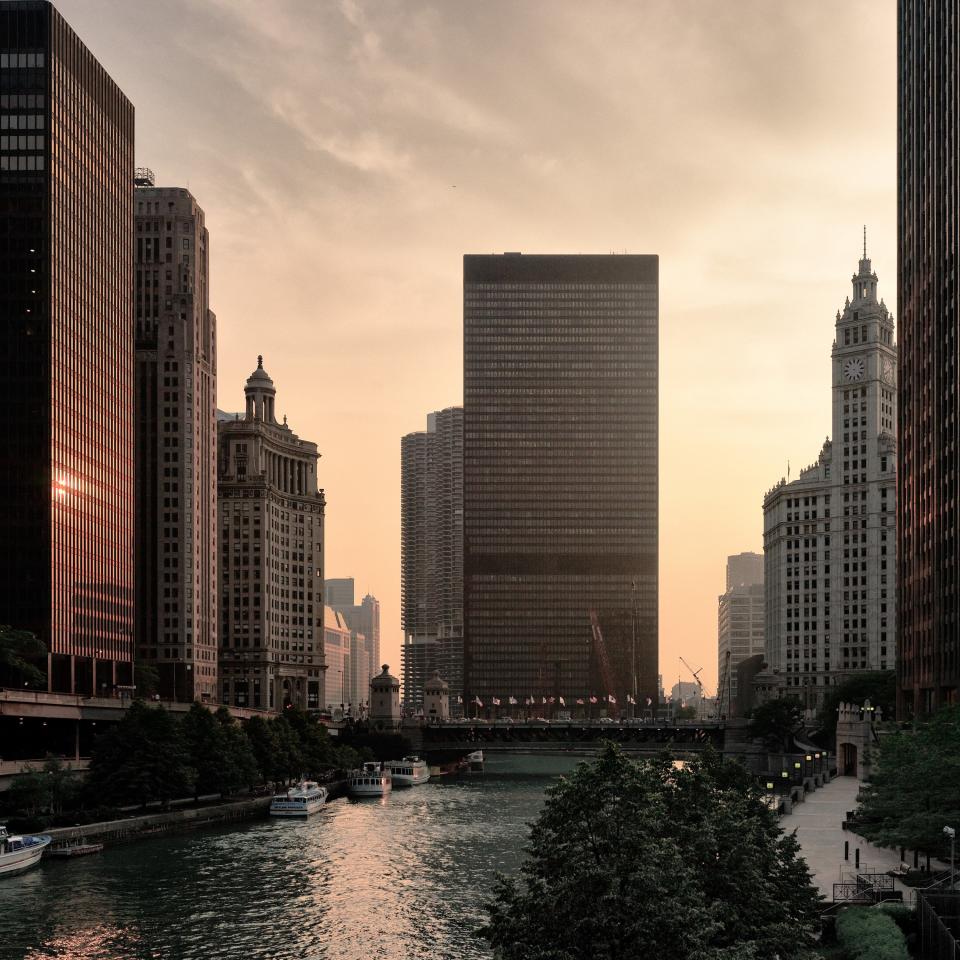
Chicago river and IBM building in Chicago at dusk
Situated in the stark black Ludwig Mies van der Rohe’s IBM Building across from the Trump building, The Langham Chicago is discreet, with few signs indicating the hotel is even located within thirteen floors of the building. However, as soon as you get off the elevator, you’re awarded with the awe-inspiring art collection, the hand-blown glass chandeliers, and floor-to-ceiling windows producing a light-bathed lobby. The rooms feature more of the hotel’s famed Bauhaus-influenced design, with large windows, and a vast art collection that is present on all floors.
For a stay that feels more like home, book a few nights in West Loop’s ultra-trendy Publishing House Bed and Breakfast. Housed in a 110-year-old former publishing home, this loft-turned-bed-and-breakfast blends minimalistic décor with contemporary design — like the addition clawfoot tubs and local artwork in the guest rooms and soft and worn leather chairs and a statement cement and slate fireplace in the middle of the lobby. Elements of the building’s history — first as a publishing house and then as a casket factory and holography museum — are seen throughout, from industrially outfitted tall ceilings and floor-to-ceiling, square-tiled windows.
Where to Eat and Drink
Go back in time for breakfast at Wormhole Coffee, a quirky and eccentric café in Wicker Park. Outfitted with a life-size DeLorean (from Back to the Future), novelty movie posters, mis-matched mugs, and ample family seating, you’ll find some of the neighborhoods hippest people here, sipping java whilst furiously typing on their laptops. For something more elevated, visit Café Robey, a bright and airy restaurant tucked inside the Robey Hotel. Here, you can enjoy avocado toasts, fresh pressed juices, and an array of delicious bites in their retro booths. Proxi, a West Loop favorite for brunch, also plays to the retro diner vibe, with orange round booth seating, large patina mirrors, large-scale house plants, and a gold-plated bar.
Bohemian vibes prevail at local favorite Beatnik by the River. This riverfront location, a newer addition to the brand, offers flamboyant design—with tasseled umbrellas, Moroccan lanterns and dozens of hanging plants. The highlight is the view, with the patio sitting right on the recently-renovated Riverwalk. Their Logan Square location, which is only open for dinner, boasts similar design and a larger range of menu and cocktail offerings.
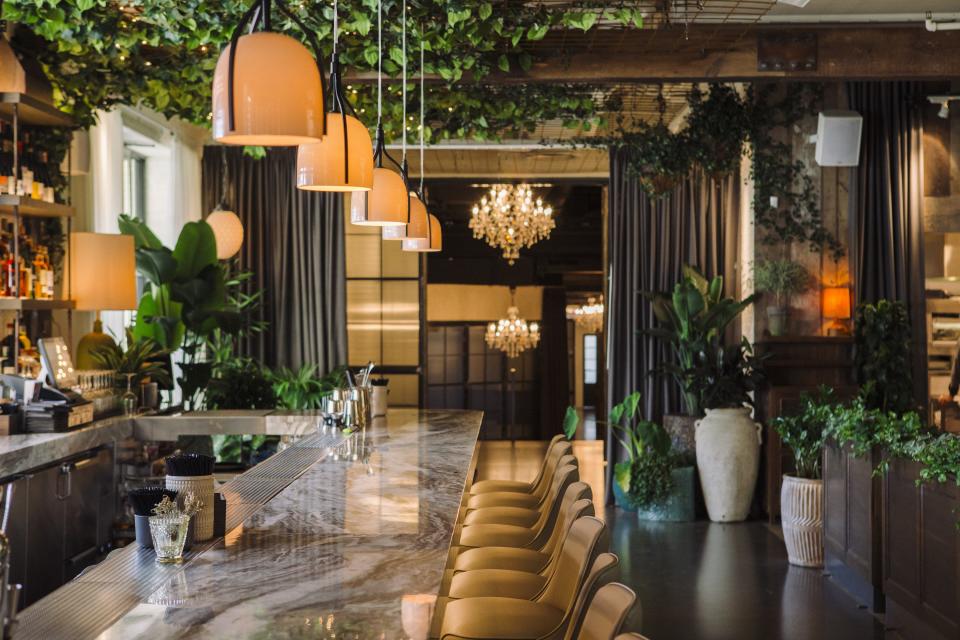
Keeping with the trend of live accents and cascading houseplants, Aba—located in hipster-haven Fulton Market—is an Instagrammer's dream. A large portico draped in English Ivy, life-size plants at every corner and a garden-themed patio with topiary bushes and lush planter boxes, Aba’s design was highly inspired by a summer in the Mediterranean and natural elements, according to senior designer Avril Zayas. “I have always loved greenery in indoor spaces," Zayas explains. "It creates a natural element that feels relatable and comfortable to guests."Boka, a dinner staple in Bucktown, also focuses on the greenery trend, touting a larger-than-life living moss wall in their private dining room. The patio, decorated with bulb lights and a small, yet verdant, garden reflects this, too.
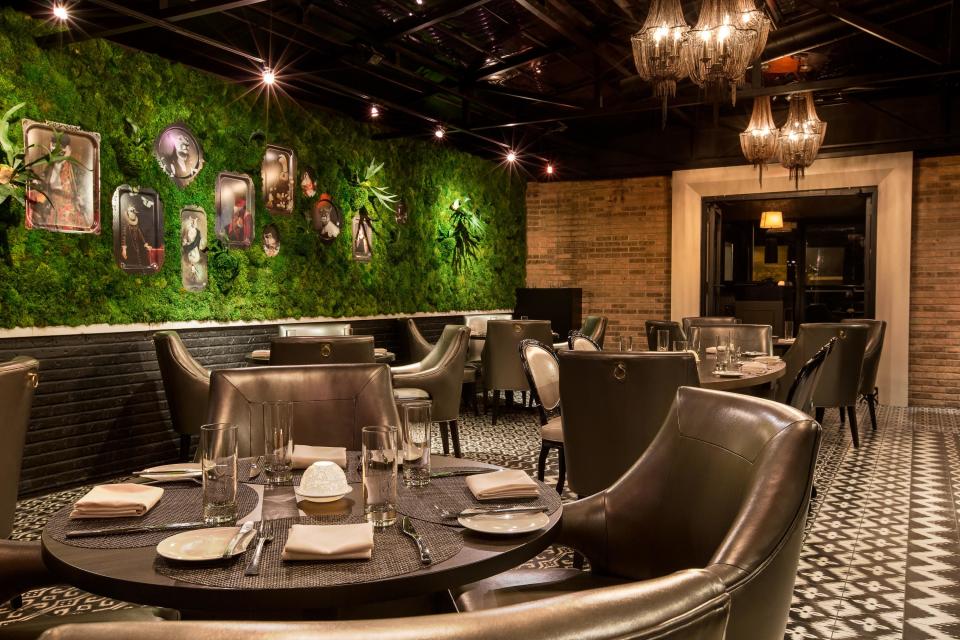
Upon entering the discreet, large black door, you’re welcomed with one of Chicago’s most famous and beautifully designed steakhouses, GT Prime. Unlike other steakhouses in the city, GT’s design theme is fairy-taled, according to lead designers Karen Herold of Studio K. The host stand is flanked with two large animal mastheads, the stools in the bar are wrapped in faux fur and rich, velvety royal purple elements can be seen throughout. The waiter’s station in the middle of the room is, ironically, the focal point—with two log cabin-esque pillars and a grandeur chandelier.
No stranger to cocktail bars, Chicago’s drinking scene has seen the biggest growth in terms of design. Z Bar, the popular rooftop spot at home in the swanky Peninsula Hotel, blends a more contemporary take than the rest of the property, however, still focuses on Chicago. “I sought inspiration from the city of Chicago, from the dramatic bean-shaped skylight set into the 13-foot-high ceiling above the bar casts light onto hand-painted mural wall coverings that feature Chicago’s signature bascule bridges. The front lounge pays subtle homage to city architecture through a vocabulary of lines and materials, including hexagonal-patterned, mixed-marble floors,” say lead designer, Yabu Pushelberg.
Throwing a nod to prohibition-era Chicago, the Violet Hour is one of the city’s most beautiful speakeasies. Hidden behind a street-art decorated brick door, the lush tapestries, tear-drop chandelier and velvet couches and chairs sit behind elegant curtains. The cocktails are just as design-forward, featuring ornate accruements. Located in the mid-century modern Conrad Hotel, Baptiste and Bottle looks and feels like a high-end whiskey bar. Custom millwork pieces showcase the restaurant’s extensive liquor collection amidst the large windows and the artwork includes a large, abstract collage of whiskey ingredients and stills, as well as a series of illustrations detailing the whiskey-making process.
What to Do
In a city that’s revered for its architecture, any design lover would be remiss not to take a Chicago Architecture Tour. There are ample ways to do this, but most opt for one of the boats. You’ll weave along the recently renovated and rebuilt riverwalk, showcasing the city’s famous skyscrapers—like the Merchandising Mart and the wave-inspired Jeanne Gang-designed Aqua skyscraper—from the water. For a more encompassing view of the city’s architecture and landscape, take a helicopter tour. You’ll get aerial views of the Windy City’s most popular landmarks. The LondonHouse hotel’s rooftop bar, located on Upper Wacker’s riverfront, also offers inspired views of Chicago’s downtown.
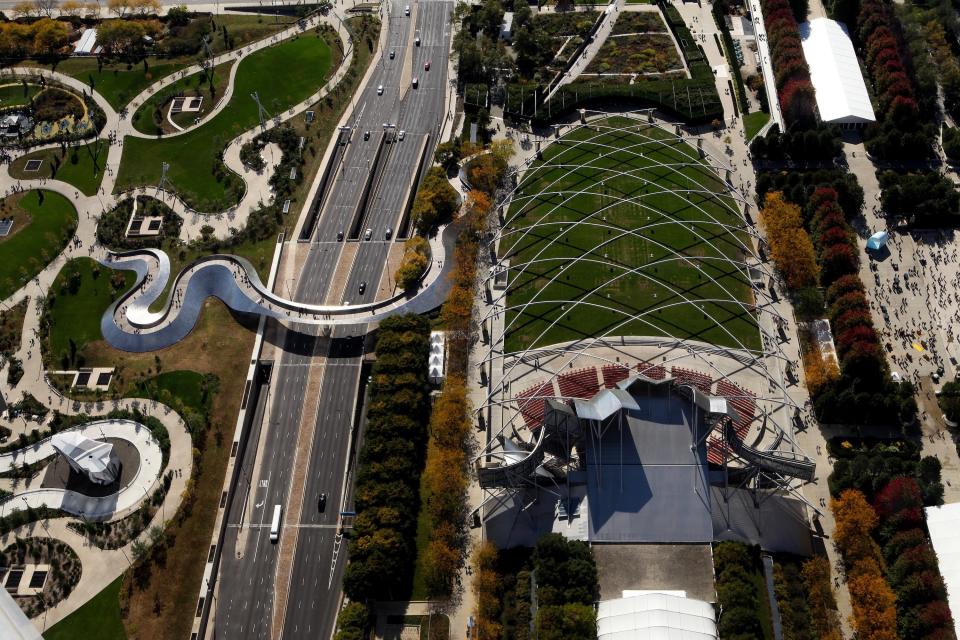
Open House Chicago 2015
Millennium Park, which was once a discarded iron railyard, is a large, public open space home to a collection of sculptures, including Anish Kapoor’s Cloud Gate and the Pritzker Pavilion, designed by starchitect Franky Gehry. Located just a few blocks away is the famous Art Institute. Designed in 1879, the Beaux-Arts style building was one of the first few constructed after the devastating fire of 1871. A college, museum, and conference center, the beautiful building also offers beautiful views of the city skyline at night. Although the outside seems rather unassuming, the interiors are what make the Chicago Cultural Center a must-see. Featuring a spectacular Tiffany Dome (one of the largest in the world) and the intricate Healy-Millet Dome, both of which are free to see.
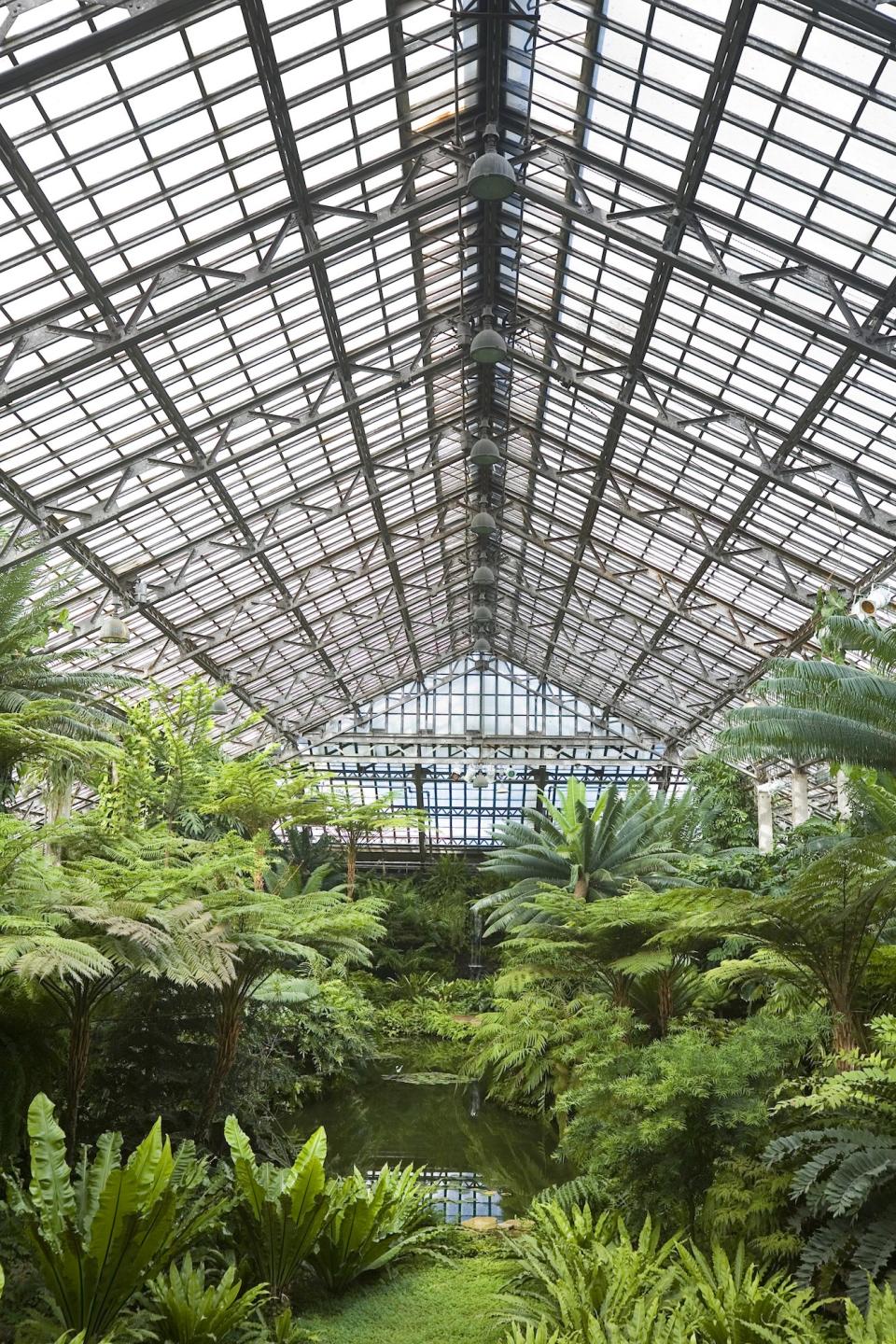
Palm House Interior
Away from the hustle of downtown, the Garfield Park Conservatory is a favorite for locals, especially in the cold winter months. This 4.5-acre conservatory is home to thousands of plants, trees and flowers, with the design focal point being the palm-fringed prismed dome you see as soon as you enter.
The real heartbeat of the city, however, lies in the neighborhoods that flank the outskirts of the downtown. A design favorite is Pilsen, a hipster borough with some of the city’s best local street art. A self-guided walk along 18th and Halsted showcase a new fusion of design-forward cafes and shops, as well as the fan-favorite National Museum of Mexican Art. The Pilsen East Artists Open House, from October 5 to 7, showcases the work of over 30 local galleries.
Two other can’t miss neighborhoods for street art, restaurants and design are Wicker Park and Andersonville. The go-to spot for design inspiration, Wicker Park is home to the city’s hippest shops, the architectural marvel Robey Hotel, and the famed Chicago mural beneath the Blue Line tracks. Here, you can hop on the 606 — the nearly 3-mile long, multi-use recreational trail that was once a former abandoned railway. Andersonville’s Swedish roots abound throughout the Northwest neighborhood—from the lush landscaping to the trendy Andersonville Galleria. Inside, the exposed brick and loft building features dozens of local vendors, selling everything from custom-made artwork to hand-stitched clothing and photography.
Originally Appeared on Architectural Digest

